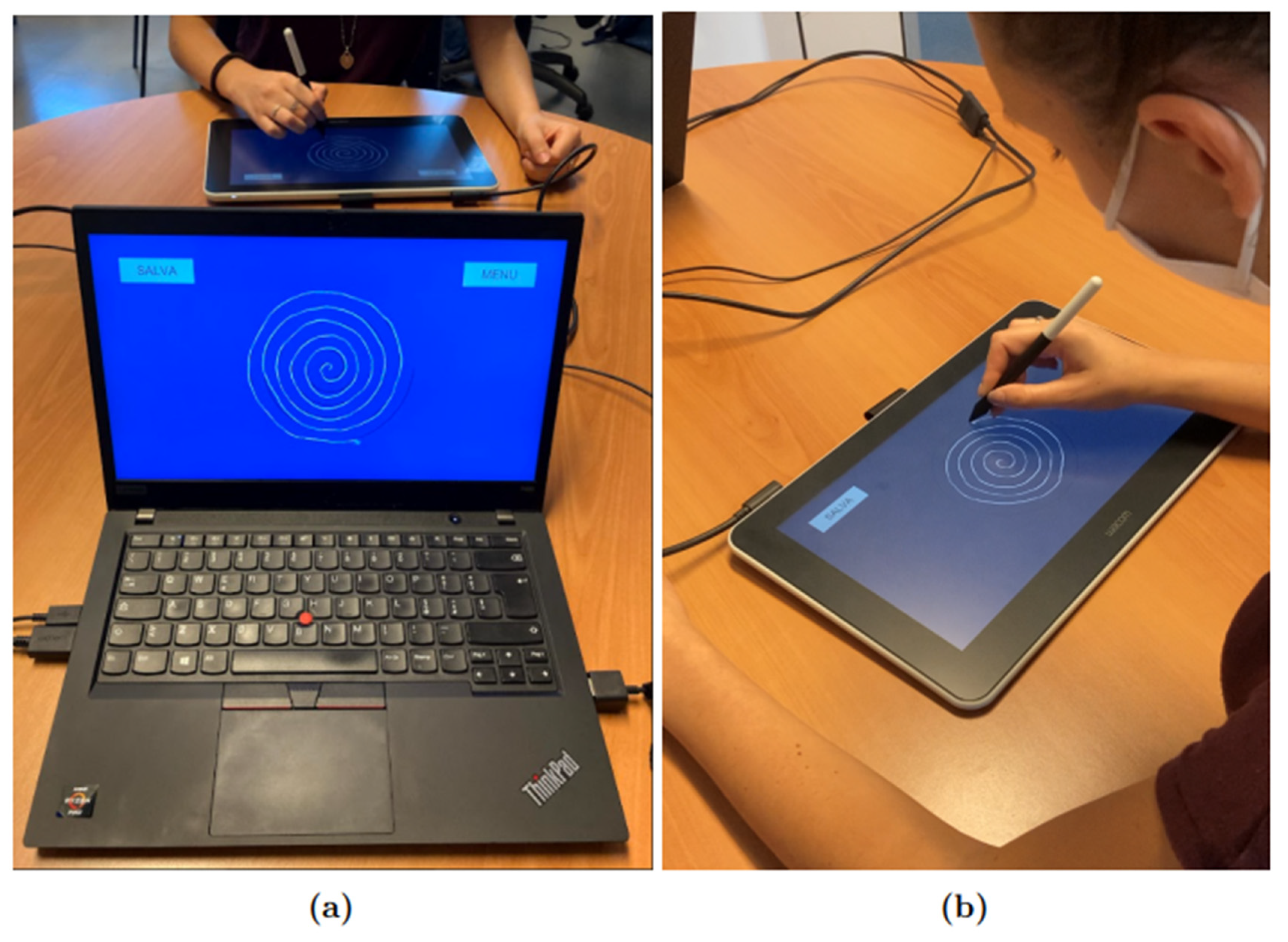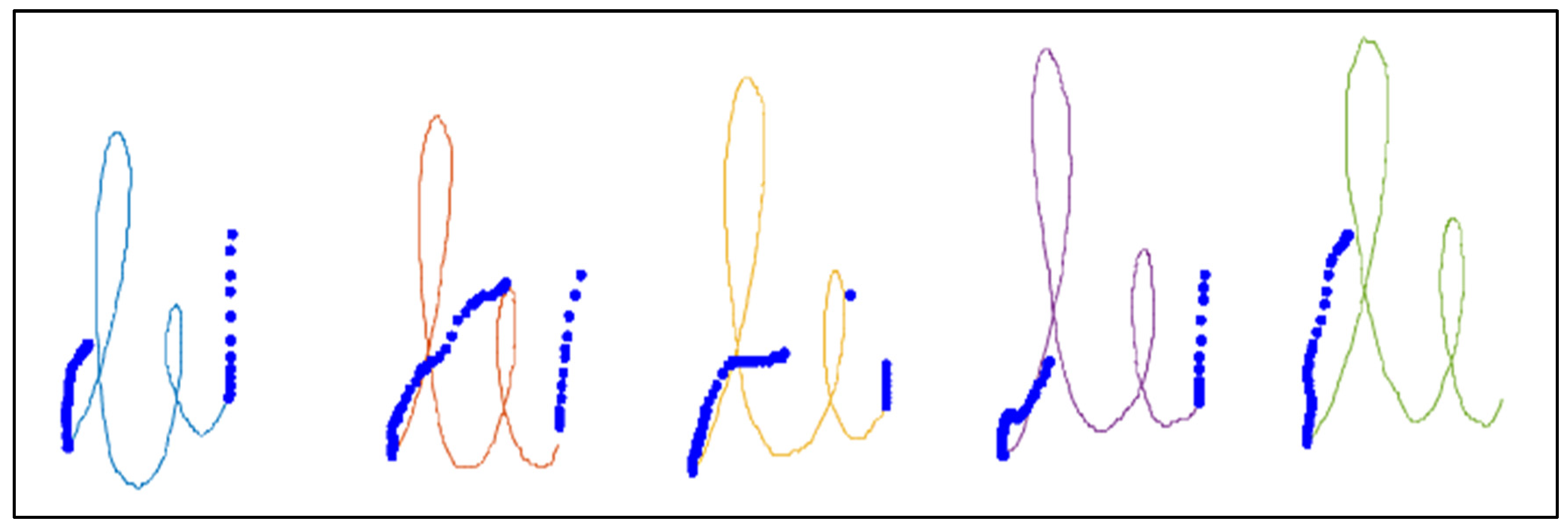Classification-Based Screening of Parkinson’s Disease Patients through Graph and Handwriting Signals †
Abstract
:1. Introduction
2. Methods and Materials
- For each point of the drawn spiral , we found the spiral guide’s closest point to it, .
- We calculated the distance of each couple of points , , as
- We found the parameterthat describes how much the drawn spiral is distant from the spiral guide. A smaller value of p meant a higher precision.
3. Results and Discussion
4. Conclusions
Author Contributions
Funding
Institutional Review Board Statement
Informed Consent Statement
Data Availability Statement
Acknowledgments
Conflicts of Interest
References
- McKeith, I.G.; Burn, D. Spectrum of parkinson’s disease, parkinson’s dementia, and lewy body dementia. Neurol. Clin. 2000, 18, 865–883. [Google Scholar] [CrossRef]
- Gupta, J.D.; Chanda, B. Novel Features for Diagnosis of Parkinson’s Disease From off-Line Archimedean Spiral Images. In Proceedings of the IEEE 10th International Conference on Awareness Science and Technology (iCAST), Morioka, Japan, 23–25 October 2019. [Google Scholar] [CrossRef]
- Tolosa, E.; Wenning, G.; Poewe, W. The diagnosis of Parkinson’s disease. Lancet Neurol. 2006, 5, 75–86. [Google Scholar] [CrossRef]
- Pereira, C.R.; Pereira, D.R.; Weber SA, T.; Hook, C.; de Albuquerque, V.H.C.; Papa, J.P. A survey on computer-assisted Parkinson’s Disease diagnosis. Artif. Intell. Med. 2019, 95, 48–63. [Google Scholar] [CrossRef] [PubMed]
- Cordella, F.; Paffi, A.; Pallotti, A. Classification-based screening of Parkinson’s disease patients through voice signal. In Proceedings of the 2021 IEEE International Symposium on Medical Measurements and Applications (MeMeA), Lausanne, Switzerland, 23–25 June 2021; pp. 1–6. [Google Scholar] [CrossRef]
- Emamzadeh, F.N.; Surguchov, A. Parkinson’s Disease: Biomarkers, Treatment, and Risk Factors. Front. Neurosci. 2018, 12, 612. [Google Scholar] [CrossRef] [PubMed]
- Zham, P.; Arjunan, S.P.; Raghav, S.; Kumar, D.K. Efficacy of Guided Spiral Drawing in the Classification of Parkinson’s Disease. IEEE J. Biomed. Health Inform. 2018, 22, 1648–1652. [Google Scholar] [CrossRef] [PubMed]
- Mazza, M.; Marano, G.; Traversi, G.; Gaetani, E.; Sani, G.; Mazza, S. Graphology: An Interface Between Biology, Psychology and Neuroscience. Psychol. Disord. Res. 2021, 2020, 1–13. [Google Scholar] [CrossRef]
- Homas, M.; Lenka, A.; Pal, P.K. Handwriting Analysis in Parkinson’s Disease: Current Status and Future Directions. Mov. Disord. Clin. Pract. 2017, 4, 806–818. [Google Scholar] [CrossRef]
- Miralles, F.; Tarongí, S.; Espino, A. Quantification of the drawing of an Archimedes spiral through the analysis of its digitized picture. J. Neurosci. Methods 2006, 152, 18–31. [Google Scholar] [CrossRef] [PubMed]
- Drotar, P.; Mekyska, J.; Rektorová, I.; Masarová, L.; Smekal, Z.; Faundez-Zanuy, M. Evaluation of handwriting kinematics and pressure for differential diagnosis of Parkinson’s disease. Artif. Intell. Med. 2016, 67, 39–46. [Google Scholar] [CrossRef] [PubMed]
- Pereira, C.R.; Pereira, D.R.; Silva, F.A.; Masieiro, J.P.; Weber, S.A.T.; Hook, C.; Papa, J.P. A new computer vision-based approach to aid the diagnosis of Parkinson’s disease. Comput. Methods Programs Biomed. 2016, 136, 79–88. [Google Scholar] [CrossRef] [PubMed]
- Pereira, C.R.; Weber SA, T.; Hook, C.; Rosa, G.H.; Papa, J. Deep Learning-aided Parkinson’s Disease Diagnosis from Handwritten Dynamics. In Proceedings of the 2016 29th SIBGRAPI Conference on Graphics, Patterns and Images (SIBGRAPI), Sao Paulo, Brazil, 4–7 October 2016. [Google Scholar] [CrossRef]
- Sadikov, A.; Zabkar, J.; Mozina, M.; Groznik, V.; Georgiev, D.; Bratko, I. ParkinsonCheck A Decision Support System for Tremor Detection. 2015. Available online: https://ailab.si/parkinsoncheck/pc-tr.pdf (accessed on 24 November 2021).
- Lamba, R.; Gulati, T.; Al-Dhlan, K.A.; Jain, A. A systematic approach to diagnose Parkinson’s disease through kinematic features extracted from handwritten drawings. J. Reliab. Intell. Environ. 2021, 7, 253–262. [Google Scholar] [CrossRef]
- Eichhorn, T.E.; Gasser, T.; Marquardt, T.; Arnold, G.; Schwarz, J.; Oertel, W.H. Computational Analysis of Open Loop Handwriting Movements in Parkinson’s Disease: A Rapid Method to Detect Dopamime tic Effects. Mov. Disordcr Soc. 1996, 11, 3. [Google Scholar] [CrossRef]
- Taleb, C.; Likforman-Sulem, L.; Khachab, M.; Mokbel, C. Feature selection for an improved Parkinson’s disease identification based on handwriting. In Proceedings of the 2017 1st International Work- shop on Arabic Script Analysis and Recognition (ASAR 2017), Nancy, France, 3–5 April 2017; pp. 52–56. [Google Scholar] [CrossRef] [Green Version]
- Senatore, R.; Marcelli, A. A paradigm for emulating the early learning stage of handwriting: Performance comparison between healthy controls and Parkinson’s disease patients in drawing loop shapes. Hum. Mov. Sci. 2019, 65, 89–101. [Google Scholar] [CrossRef]
- Tappert, C.C.; Suen, C.Y.; Wakahara, T. The state of the art in online handwriting recognition. IEEE Trans. Pattern Anal. Mach. Intell. 1990, 12, 787–808. [Google Scholar] [CrossRef] [Green Version]
- Drotar, P.; Mekyska, J.; Rektorová, I.; Masarová, L.; Smékal, Z.; Faundez-Zanuy, M. Analysis of in-air movement in handwriting: A novel marker for Parkinson’s disease. Comput. Methods Programs Biomed. 2014, 117, 405–411. [Google Scholar] [CrossRef]
- UNESCO Institute for Statistics. International Standard Classification of Education: ISCED 2011; UIS: Montreal, QC, Canada, 2021. [Google Scholar] [CrossRef]
- International Standard Classification of Education (ISCED)—Statistics Explained (europa.eu). 2021. Available online: https://ec.europa.eu/eurostat/statistics-explained/index.php?title=International_Standard_Classification_of_Education_(ISCED) (accessed on 25 November 2021).
- Bhidayasiri, R.; Tarsy, D. Parkinson’s Disease: Hoehn and Yahr Scale. In Movement Disorders: A Video Atlas; Current Clinical Neurology; Humana: Totowa, NJ, USA, 2012. [Google Scholar] [CrossRef]




| Group | Age (Mean ± SD) | Number Male/Female | Middle Finger–Wrist Distance (cm) (Mean ± SD) | Level of Education (ISCED 2011) (Mean ± SD) |
|---|---|---|---|---|
| C | 55.8 ± 6.5 | 8/14 | 19.6 ± 1.8 | 5.1 ± 2.1 |
| PD | 69.3 ± 10 | 5/4 | - | - |
| Patient ID | H&Y | Side | Years since Diagnosis | LEDD |
|---|---|---|---|---|
| #1 | 2 | Left | 3 | 450 |
| #2 | 3 | Left | 2 | 750 |
| #3 | 2 | Bilateral | 1 | 200 |
| #4 | 3 | Right | 6 | 625 |
| #5 | 3 | Left | 11 | 400 |
| #6 | 3 | Left | 4 | 250 |
| #7 | 4 | Bilateral | 4 | 400 |
| #8 | 1 | Right | 1 | 50 |
| #9 | 3 | Left | 13 | 900 |
| Features | Task |
|---|---|
| Velocity: absolute, vertical, and horizontal | 1,2 |
| Acceleration: absolute, vertical, and horizontal | 1,2 |
| Jerk: absolute, vertical, and horizontal | 1,2 |
| Radial velocity | 1 |
| Angular velocity | 1 |
| Variation of velocity, acceleration, and stroke between components | 2 |
| Number of changes of direction in velocity | 1,2 |
| Number of changes of direction in acceleration | 1,2 |
| Number of changes of direction in jerk | 1,2 |
| Normalized in-air time (time in air over total time) | 1,2 |
| In-air velocity: absolute, vertical, and horizontal | 2 |
| In-air acceleration: absolute, vertical, and horizontal | 2 |
| In-air jerk: absolute, vertical, and horizontal | 2 |
| Power spectral density of the absolute velocity | 1 |
| Spiral | le |
|---|---|
| skewness of the pen acceleration on the x axis | mean of the maximum pen velocity on the y axis of the single le component in the air |
| kurtosis of the pen velocity on the x axis | mean of the range of the pen velocity on the y axis of the single le component in the air |
| 25th percentile of the power spectral density of the absolute pen velocity | maximum of the acceleration on the x axis in the air |
| Spiral | le | Spiral and le | |
|---|---|---|---|
| Model | Linear SVM | Linear SVM | Medium KNN |
| Accuracy | 71.6% | 75.5% | 77.5% |
| Specificity | 79% | 73.7% | 77.1% |
| Sensitivity | 62.2% | 77.8% | 77.8% |
| F1 Score | 65.9% | 73.7% | 75.3% |
| Precision | 70% | 70% | 72.9% |
Publisher’s Note: MDPI stays neutral with regard to jurisdictional claims in published maps and institutional affiliations. |
© 2021 by the authors. Licensee MDPI, Basel, Switzerland. This article is an open access article distributed under the terms and conditions of the Creative Commons Attribution (CC BY) license (https://creativecommons.org/licenses/by/4.0/).
Share and Cite
Fratello, M.; Cordella, F.; Albani, G.; Veneziano, G.; Marano, G.; Paffi, A.; Pallotti, A. Classification-Based Screening of Parkinson’s Disease Patients through Graph and Handwriting Signals. Eng. Proc. 2021, 11, 49. https://doi.org/10.3390/ASEC2021-11128
Fratello M, Cordella F, Albani G, Veneziano G, Marano G, Paffi A, Pallotti A. Classification-Based Screening of Parkinson’s Disease Patients through Graph and Handwriting Signals. Engineering Proceedings. 2021; 11(1):49. https://doi.org/10.3390/ASEC2021-11128
Chicago/Turabian StyleFratello, Maria, Fulvio Cordella, Giovanni Albani, Giuseppe Veneziano, Giuseppe Marano, Alessandra Paffi, and Antonio Pallotti. 2021. "Classification-Based Screening of Parkinson’s Disease Patients through Graph and Handwriting Signals" Engineering Proceedings 11, no. 1: 49. https://doi.org/10.3390/ASEC2021-11128
APA StyleFratello, M., Cordella, F., Albani, G., Veneziano, G., Marano, G., Paffi, A., & Pallotti, A. (2021). Classification-Based Screening of Parkinson’s Disease Patients through Graph and Handwriting Signals. Engineering Proceedings, 11(1), 49. https://doi.org/10.3390/ASEC2021-11128









